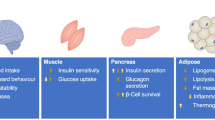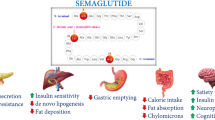Abstract
Purpose
Glucagon like peptide-1 (GLP-1) is produced to induce postprandial insulin secretion. Liraglutide, a full agonist of the GLP-1 receptor, has a protective effect on weight gain in obese subjects. Brown adipose tissue plays a major role in the control of energy balance and is known to be involved in the weight loss regulated by liraglutide. The putative anti-obesity properties of liraglutide and the cell signaling pathways involved were examined.
Methods
Four groups of C57/BL6 mice fed with chow or HFHS diet were injected with either liraglutide or vehicle for four weeks. Western blotting was used to analyze protein expression.
Results
Liraglutide significantly attenuated the weight gain in mice fed with HFHS diet and was associated with significant reductions of epididymal fat and inguinal fat mass. Furthermore, liraglutide significantly upregulated the expression of brown adipose-specific markers in perigonadal fat in association with upregulation of AMPK-SIRT-1-PGC1-α cell signaling. However, elevation of brown fat markers in skeletal muscle was only observed in HFHS diet fed mice after liraglutide treatment, and AMPK-SIRT-1 cell signaling is not involved in this process.
Conclusions
the anti-obesity effect of liraglutide occurs through adaptive thermogenesis and may act through different cell signaling pathways in fat and skeletal muscle tissue. Liraglutide induces beige fat development partially through the AMPK-SIRT-1-PGC1-α cell signaling pathway. Therefore, liraglutide is a potential medication for obesity prevention and in targeting pre-diabetics.







Similar content being viewed by others
References
C.L. Ogden, M.D. Carroll, B.K. Kit, K.M. Flegal, Prevalence of obesity in the United States, 2009-2010. NCHS Data Brief 82, 1–8 (2012)
C.S. Elangbam, Review paper: current strategies in the development of anti-obesity drugs and their safety concerns. Vet. Pathol. 46, 10–24 (2009)
W.C. Knowler, E. Barrett-Connor, S.E. Fowler, R.F. Hamman, J.M. Lachin, E.A. Walker et al. Reduction in the incidence of type 2 diabetes with lifestyle intervention or metformin. N. Engl. J. Med. 346, 393–403 (2002)
D.H. Ryan, G.A. Bray, Pharmacologic treatment options for obesity: what is old is new again. Curr. Hypertens. Rep. 15, 182–189 (2013)
D.J. Drucker, Biological actions and therapeutic potential of the glucagon-like peptides. Gastroenterology 122, 531–544 (2002)
E. Tomas, J.A. Wood, V. Stanojevic, J.F. Habener, Glucagon-like peptide-1(9-36)amide metabolite inhibits weight gain and attenuates diabetes and hepatic steatosis in diet-induced obese mice. Diabetes Obes. Metab. 13, 26–33 (2011)
L.B. Knudsen, Liraglutide: the therapeutic promise from animal models. Int. J. Clin. Pract. 167, 4–11 (2010)
J.J. Meier, GLP-1 receptor agonists for individualized treatment of type 2 diabetes mellitus. Nat. Rev. Endocrinol. 8, 728–742 (2012)
S.C. Tang, J.J. Hendrikx, J.H. Beijnen, A.H. Schinkel, Genetically modified mouse models for oral drug absorption and disposition. Curr. Opin. Pharmacol. 13, 853–858 (2013)
M. Namba, T. Katsuno, Y. Kusunoki, T. Matsuo, M. Miuchi, J. Miyagawa, New strategy for the treatment of type 2 diabetes mellitus with incretin-based therapy. Clin. Exp. Nephrol. 17, 10–15 (2013)
M. Zander, S. Madsbad, J.L. Madsen, J.J. Holst, Effect of 6-week course of glucagon-like peptide 1 on glycaemic control, insulin sensitivity, and beta-cell function in type 2 diabetes: a parallel-group study. Lancet 359, 824–830 (2002)
S. Madsbad, The role of glucagon-like peptide-1 impairment in obesity and potential therapeutic implications. Diabetes Obes. Metab. 16, 9–21 (2014)
S. Kalra, B. Kalra, S. Kumar, A. Sharma, Managing insulin resistance: role of liraglutide. Clin. Pharmacol. 2, 131–134 (2010)
S.H. Kim, F. Abbasi, C. Lamendola, A. Liu, D. Ariel, P. Schaaf et al. Benefits of liraglutide treatment in overweight and obese older individuals with prediabetes. Diabetes Care 36, 3276–3282 (2013)
K.M. Heppner, S. Marks, J. Holland, N. Ottaway, D. Smiley, R. Dimarchi et al. Contribution of brown adipose tissue activity to the control of energy balance by GLP-1 receptor signalling in mice. Diabetologia 58, 2124–2132 (2015)
M. Giralt, F. Villarroya, White, brown, beige/brite: different adipose cells for different functions? Endocrinology 154, 2992–3000 (2013)
A.M. Cypess, C.R. Kahn, The role and importance of brown adipose tissue in energy homeostasis. Curr. Opin. Pediatr. 22, 478–484 (2010)
D. Beiroa, M. Imbernon, R. Gallego, A. Senra, D. Herranz, F. Villarroya et al. GLP-1 agonism stimulates brown adipose tissue thermogenesis and browning through hypothalamic AMPK. Diabetes 63, 3346–3358 (2014)
L.X. Li, P.E. MacDonald, D.S. Ahn, G.Y. Oudit, P.H. Backx, P.L. Brubaker, Role of phosphatidylinositol 3-kinasegamma in the beta-cell: interactions with glucagon-like peptide-1. Endocrinology 147, 3318–3325 (2006)
A. Park, W.K. Kim, K.H. Bae, Distinction of white, beige and brown adipocytes derived from mesenchymal stem cells. World J. Stem Cells 6, 33–42 (2014)
E.E. Ladenheim, Liraglutide and obesity: a review of the data so far. Drug Des. Devel Ther. 9, 1867–1875 (2015)
M.A. Zuriaga, J.J. Fuster, N. Gokce, K. Walsh, Humans and mice display opposing patterns of “browning” gene expression in visceral and subcutaneous white adipose tissue depots. Front. Cardiovasc. Med. 4, 27 (2017)
E.D. Rosen, C.H. Hsu, X. Wang, S. Sakai, M.W. Freeman, F.J. Gonzalez et al. C/EBPalpha induces adipogenesis through PPARgamma: a unified pathway. Genes Dev. 16, 22–26 (2002)
M. Rosell, M. Kaforou, A. Frontini, A. Okolo, Y.W. Chan, E. Nikolopoulou et al. Brown and white adipose tissues: intrinsic differences in gene expression and response to cold exposure in mice. Am. J. Physiol. Endocrinol. Metab. 306, E945–964 (2014)
M. Harms, P. Seale, Brown and beige fat: development, function and therapeutic potential. Nat. Med. 19, 1252–1263 (2013)
J.I. Kim, J.Y. Huh, J.H. Sohn, S.S. Choe, Y.S. Lee, C.Y. Lim et al. Lipid-overloaded enlarged adipocytes provoke insulin resistance independent of inflammation. Mol. Cell. Biol. 35, 1686–1699 (2015)
W. Wang, P. Seale, Control of brown and beige fat development. Nat. Rev. Mol. Cell Biol. 17, 691–702 (2016)
R.C. Scarpulla, Metabolic control of mitochondrial biogenesis through the PGC-1 family regulatory network. Biochim. Biophys. Acta 1813, 1269–1278 (2011)
K.L. Townsend, D. An, M.D. Lynes, T.L. Huang, H. Zhang, L.J. Goodyear et al. Increased mitochondrial activity in BMP7-treated brown adipocytes, due to increased CPT1- and CD36-mediated fatty acid uptake. Antioxid. Redox Signal. 19, 243–257 (2013)
W. Lea, A.S. Abbas, H. Sprecher, J. Vockley, H. Schulz, Long-chain acyl-CoA dehydrogenase is a key enzyme in the mitochondrial beta-oxidation of unsaturated fatty acids. Biochim. Biophys. Acta 1485, 121–128 (2000)
B. Cannon, J. Nedergaard, Brown adipose tissue: function and physiological significance. Physiol. Rev. 84, 277–359 (2004)
E. García-Ruiz, B. Reynés, R. Díaz-Rúa, E. Ceresi, P. Oliver, A. Palou, The intake of high-fat diets induces the acquisition of brown adipocyte gene expression features in white adipose tissue. Int. J. Obes. 39, 1619–1629 (2015)
P. Seale, B. Bjork, W. Yang, S. Kajimura, S. Chin, S. Kuang et al. PRDM16 controls a brown fat/skeletal muscle switch. Nature 454, 961–967 (2008)
X. Pi-Sunyer, A. Astrup, K. Fujioka, F. Greenway, A. Halpern, M. Krempf et al. A randomized, controlled trial of 3.0 mg of liraglutide in weight management. N. Engl. J. Med. 373, 11–22 (2015)
J. van Can, B. Sloth, C.B. Jensen, A. Flint, E.E. Blaak, W.H. Saris, Effects of the once-daily GLP-1 analog liraglutide on gastric emptying, glycemic parameters, appetite and energy metabolism in obese, non-diabetic adults. Int. J. Obes. 38, 784–793 (2014)
K. Raun, P. von Voss, C.F. Gotfredsen, V. Golozoubova, B. Rolin, L.B. Knudsen, Liraglutide, a long-acting glucagon-like peptide-1 analog, reduces body weight and food intake in obese candy-fed rats, whereas a dipeptidyl peptidase-IV inhibitor, vildagliptin, does not. Diabetes 56, 8–15 (2007)
M.J. Davies, R. Bergenstal, B. Bode, R.F. Kushner, A. Lewin, T.V. Skjøth et al. Efficacy of liraglutide for weight loss among patients with type 2 diabetes: the SCALE diabetes randomized clinical trial. JAMA 314, 687–699 (2015)
M. Nauck, A. Frid, K. Hermansen, N.S. Shah, T. Tankova, I.H. Mitha et al. Efficacy and safety comparison of liraglutide, glimepiride, and placebo, all in combination with metformin, in type 2 diabetes: the LEAD (liraglutide effect and action in diabetes)-2 study. Diabetes Care 32, 84–90 (2009)
M. Ahmadian, J.M. Suh, N. Hah, C. Liddle, A.R. Atkins, M. Downes et al. PPARγ signaling and metabolism: the good, the bad and the future. Nat. Med. 19, 557–566 (2013)
M.S. Choi, Y.J. Kim, E.Y. Kwon, J.Y. Ryoo, S.R. Kim, U.J. Jung, High-fat diet decreases energy expenditure and expression of genes controlling lipid metabolism, mitochondrial function and skeletal system development in the adipose tissue, along with increased expression of extracellular matrix remodelling- and inflammation-related genes. Br. J. Nutr. 113, 867–877 (2015)
Y.H. Lee, A.P. Petkova, E.P. Mottillo, J.G. Granneman, In vivo identification of bipotential adipocyte progenitors recruited by β3-adrenoceptor activation and high-fat feeding. Cell. Metab. 15, 480–491 (2012)
K. Ban, M.H. Noyan-Ashraf, J. Hoefer, S.S. Bolz, D.J. Drucker, M. Husain, Cardioprotective and vasodilatory actions of glucagon-like peptide 1 receptor are mediated through both glucagon-like peptide 1 receptor-dependent and -independent pathways. Circulation 117, 2340–2350 (2008)
F.R. Jornayvaz, G.I. Shulman, Regulation of mitochondrial biogenesis. Essays Biochem. 47, 69–84 (2010)
P. Puigserver, B.M. Spiegelman, Peroxisome proliferator-activated receptor-gamma coactivator 1 alpha (PGC-1 alpha): transcriptional coactivator and metabolic regulator. Endocr. Rev. 24, 78–90 (2003)
K.A. Virtanen, M.E. Lidell, J. Orava, M. Heglind, R. Westergren, T. Niemi et al. Functional brown adipose tissue in healthy adults. N. Engl. J. Med. 360, 1518–1525 (2009)
W.D. van Marken Lichtenbelt, J.W. Vanhommerig, N.M. Smulders, J.M. Drossaerts, G.J. Kemerink, N.D. Bouvy et al. Cold-activated brown adipose tissue in healthy men. N. Engl. J. Med. 360, 1500–1508 (2009)
S.R. Farmer, Regulation of PPARgamma activity during adipogenesis. Int. J. Obes. 29(Suppl 1), S13–16 (2005)
J.R. Jones, C. Barrick, K.A. Kim, J. Lindner, B. Blondeau, Y. Fujimoto et al. Deletion of PPARgamma in adipose tissues of mice protects against high fat diet-induced obesity and insulin resistance. Proc. Natl Acad. Sci. USA 102, 6207–6212 (2005)
J. Decara, S. Arrabal, D. Beiroa, P. Rivera, A. Vargas, A. Serrano et al. Antiobesity efficacy of GLP-1 receptor agonist liraglutide is associated with peripheral tissue-specific modulation of lipid metabolic regulators. Biofactors 42, 600–611 (2016)
Y. Shao, G. Yuan, J. Zhang, X. Guo, Liraglutide reduces lipogenetic signals in visceral adipose of db/db mice with AMPK activation and Akt suppression. Drug Des. Devel Ther. 9, 1177–1184 (2015)
G. Svegliati-Baroni, S. Saccomanno, C. Rychlicki, L. Agostinelli, S. De Minicis, C. Candelaresi et al. Glucagon-like peptide-1 receptor activation stimulates hepatic lipid oxidation and restores hepatic signalling alteration induced by a high-fat diet in nonalcoholic steatohepatitis. Liver. Int. 31, 1285–1297 (2011)
B.B. Zhang, G. Zhou, C. Li, AMPK: an emerging drug target for diabetes and the metabolic syndrome. Cell. Metab. 9, 407–416 (2009)
R. Siersbaek, R. Nielsen, S. Mandrup, PPARgamma in adipocyte differentiation and metabolism--novel insights from genome-wide studies. FEBS Lett. 584, 3242–3249 (2010)
A. Astrup, S. Rössner, L. Van Gaal, A. Rissanen, L. Niskanen, M. Al Hakim et al. Effects of liraglutide in the treatment of obesity: a randomised, double-blind, placebo-controlled study. Lancet 374, 1606–1616 (2009)
J. Rosenstock, L.J. Klaff, S. Schwartz, J. Northrup, J.H. Holcombe, K. Wilhelm et al. Effects of exenatide and lifestyle modification on body weight and glucose tolerance in obese subjects with and without pre-diabetes. Diabetes Care 33, 1173–1175 (2010)
C.W. le Roux, A. Astrup, K. Fujioka, F. Greenway, D.C.W. Lau, L. Van Gaal et al. 3 years of liraglutide versus placebo for type 2 diabetes risk reduction and weight management in individuals with prediabetes: a randomised, double-blind trial. Lancet 389, 1399–1409 (2017)
Acknowledgements
L.L. is supported by the new faculty start-up fund from Central Michigan University. The authors thank Jamsheed Bahaee, and Mellissa Andrew for their technical support and Darren Story for the editing of English grammar.
Author information
Authors and Affiliations
Corresponding author
Ethics declarations
Conflict of interest
The authors declare that they have no conflict of interest.
Rights and permissions
About this article
Cite this article
Zhou, J., Poudel, A., Chandramani-Shivalingappa, P. et al. Liraglutide induces beige fat development and promotes mitochondrial function in diet induced obesity mice partially through AMPK-SIRT-1-PGC1-α cell signaling pathway. Endocrine 64, 271–283 (2019). https://doi.org/10.1007/s12020-018-1826-7
Received:
Accepted:
Published:
Issue Date:
DOI: https://doi.org/10.1007/s12020-018-1826-7




